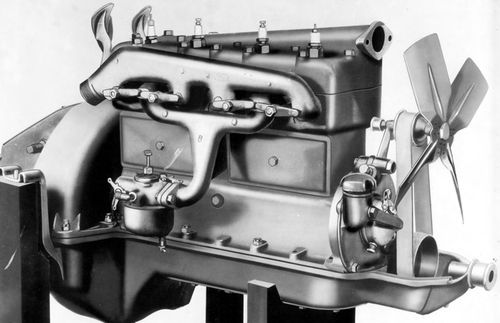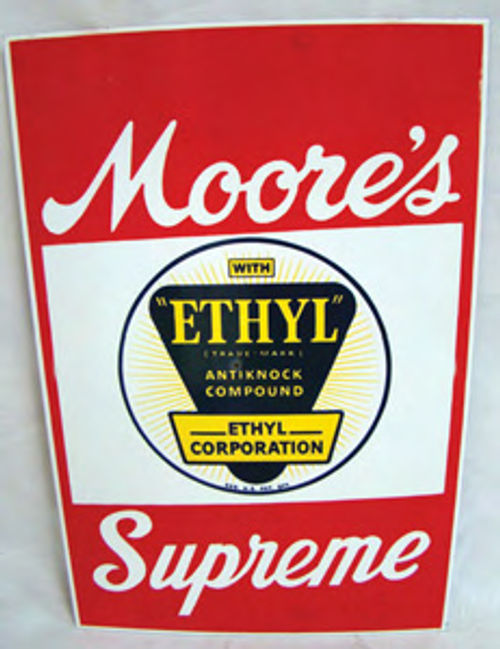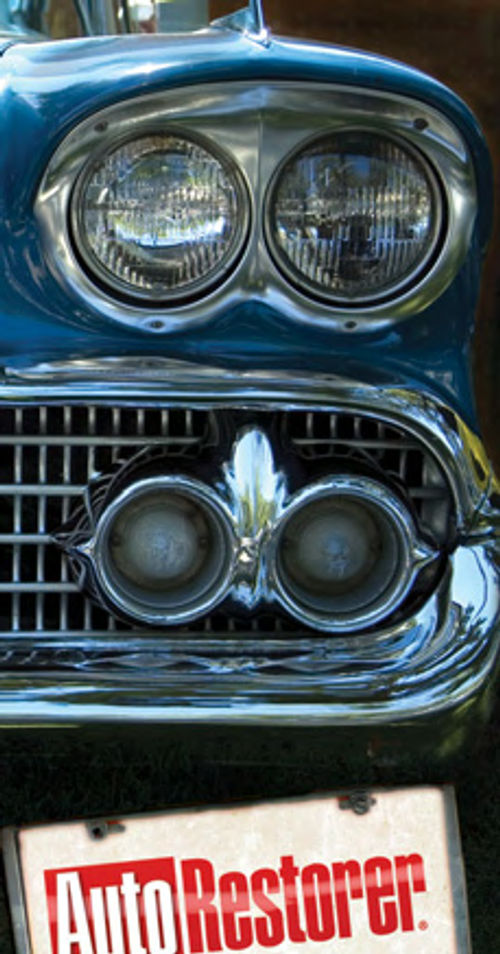Special Report A Closer Look at Octane

There Are Numerous Misconceptions About Octane Ratings. So, We Asked a Chemist to Discuss the Subject.
WE HAVE JUST three choices when we pull up to the pump for gasoline: regular, mid-grade and premium under many brand names. Does it matter which grade we select?
Of course it matters. One reason is that we do not want our engine knocking or pinging. Engine knock is a classic symptom of auto ignition or pre-ignition. Heavy, persistent knocking will damage an engine, particularly the piston rods and bearings. Causes of this knocking include low-octane fuel and a heavy foot on the gas pedal.
The Evolution of Engines
Before trying to define octane, let’s look back 100 years to a time when the octane number was unknown and Henry Ford had Model Ts rolling down his assembly line.
The Model T had a spark-ignited, internal combustion, 4-cylinder engine that produced 20 horsepower at about a 4:1 compression ratio. That engine was known to sometimes knock or ping, causing engine damage.
By that time engine builders had figured out that knock had something to do with the compression ratio and the limit was around 4:1.
However, the marketplace wanted more speed and power from automobile engines. The design choices to meet that demand were: build engines with more cylinders, a larger cylinder bore…or an increased compression ratio. Economics would dictate higher compression ratios because this would add far less weight to the engine than more cylinders. But first they had to get around the knock issue.
Although not known at the time, the gasoline in use had an octane rating somewhere around 70. The petroleum refining industry was in its infancy, as was automobile manufacturing.
Then, dramatic changes began in the 1920's in practically everything associated with an automobile, and in the early 1920s, chemists began to understand the cause of engine knock. They tried fuels such as ethanol and benzene, which eliminated the pinging. But, because of technical issues and cost, these never made it to the marketplace.
By 1923, lead compounds such as tetraethyllead (common name “tetraethyllead” or “TEL”), had been discovered and were being blended into gasoline to reduce knock. (We’ll take a closer look at leaded gasoline later in this article.)
The use of TEL to reduce knock opened the door for higher compression engines. Meanwhile, chemists came to understand and define an octane rating system. By the early 1930s, all of this knowledge was being built into engines as reflected by the 5.5 ratio in the ’32 Ford V-8 (see table below).
Year Cyl. HP Compression
1908 4 20 3.98:1
1932 V-8 65 5.5
1941 6 90 6.7
1955 V-8 162 7.6
1961 V-8 220 8.9
1971 V-8 360 10.5
That was a look at how Ford (naturally aspirated) engines evolved. Notice in the table on the previous page that horsepower and compression ratio moved hand-in-hand. Clearly, the fuels had to be changing to satisfy the higher compression engines. That change was to a higher-octane fuel.
Defining “Octane”
What is an octane number? Here’s one response from Webster’s:
“The number that is used to measure the antiknock properties of a liquid motor fuel and that represents the percentage by volume of isooctane in a reference fuel consisting of a mixture of isooctane and normal heptane and matching the knocking properties of the fuel being tested.”
Chemists reading this definition may scoff that there isn’t enough depth to the chemistry actually involved. However,I think this provides just enough detail to help readers understand what octane is and how it affects an engine.
We’ll begin by taking a closer look at some terms used in Webster’s definition.
Consider “liquid motor fuel”: This is motor gasoline we use in our cars and trucks. In this article, fuel will mean the gasoline used in spark-ignited internal combustion engines.
“Octane” itself has two definitions of interest. One is the hydrocarbon molecule that has eight carbon atoms and eighteen atoms of hydrogen.The otheris Webster’s quoted earlier. The “octa” in octane comes from the Latin for eight; “hepta,”asin heptanes, is seven, and “penta” is five.
“Engine knock”: To some, engine knock (or ping) is the sound occurring when you tromp on the accelerator, pushing the engine toward maximum acceleration, although we may hear engine knock while simply cruising at highway speeds. The sound (actually vibrations) is similar to shaking a metal can containing small rocks and, as noted earlier, the vibration is never good in an engine.
Knocking, this explosive burning of the air/fuel mixture in one or more cylinders, is caused by auto ignition. In all cases of engine knock, the fuel mixture begins burning before the spark leaps across the plug gap. On the other hand, when the air/fuel mixture is ignited by a spark, a smooth wall of flame progresses across the cylinder. (By the way, the terms “knocking” and “pinging” are interchangeable, and pre-ignition is the same thing as auto ignition.)
Again, auto ignition occurs when the air/fuel mixture ignites with no source of spark or flame present. (Glowing carbon deposits in the engine can cause the mixture to ignite early. But that is not auto ignition; it’s a symptom of a dirty engine.)

What Leads to Those Knocks
What causes auto ignition? It occurs when conditions (particularly temperature, pressure, air/fuel ratio and octane rating of the fuel) are such that the air/fuel mixture self-ignites.
Furthermore, knock usually occurs under full throttle conditions. Why? At full throttle, pressure at the intake manifold is highest (least vacuum). So the pressure at the top of the compression stroke will be its highest and with higher pressures come higher temperatures. These are ideal conditions for a fuel to self-ignite.
As noted, knocking occurs during the compression stroke before the spark jumps across the plug gap. The burning fuel mixture exerts tremendous downward pressure on the piston that is still moving up to the top of its stroke (the place we know as top dead center or TDC). This is how engine damage happens.
Now, you may be thinking that ignition always occurs before TDC, and that is true. But recognize that the mixture doesn’t burn instantaneously and with spark ignition it takes time for the wall of flame to progress across the cylinder. Thus, under normal conditions, the majority of the burn occurs just after TDC on the power stroke.
Now, let’s look at the chemical makeup of some of the items in our discussion.
“Saturated Hydrocarbons”
Hydrocarbons are molecules that contain only atoms of carbon and hydrogen. A saturated hydrocarbon molecule contains the maximum possible number of hydrogen atoms for the amount of carbon in that molecule.
“Normal Heptane and Isooctane”
The term“normal” (or “n-”) preceding a saturated hydrocarbon name tells us that the chain of carbon atoms is straight; it has no branches. Webster tells us that normal heptane (7 carbon atoms)always has a 0 octane rating. That further tells us that a straight chain of n-heptane auto ignites with relatively little compression and temperature; that would occur early in the compression stroke of almost any engine.
By comparison, isooctane (more correctly named 2,2,4 trimethylpentane) with 8 carbon atoms, is a highly branched molecule and was given an octane rating of 100.
The diagrams presented in this article show only the carbon atoms of the molecules, with the hydrogen atoms stripped away, to present a clearer picture of how the carbon atoms are arranged. A straight chain of our 8-carbon atom molecule is also possible.
The table below shows that the octane rating decreases as the straight carbon chain gets longer. It follows then that longer straight-chain saturated hydrocarbons are more prone to auto ignition; they have lower octane ratings and can even have negative octane numbers.
No of Carbon Atoms Research Octane Number Boiling Point, °F
n-butane 4 91 31
n-pentane 5 62 97
n-hexane 6 25 156
n-heptane 7 0 209
n-octane 7 -10 258
isooctane 8 100 211
The carbon atoms and octane of a few other chemicals will be of interest to us later in this discussion (see next chart):
benzene 6 101
toluene 7 111
ethanol 2 129
Those Branches Are Important
Next, compare the octane rating of isooctane to everything above it (the straight chains). The extensive branching of the isooctane is the reason for its high octane rating. More branching of the carbon atoms in a molecule results in a higher octane rating. Higher octane means higher auto ignition temperatures and, therefore, less tendency to cause knocking or pinging.
There are two reasons that n-heptane and isooctane were selected as the reference fuels for octane determination. One, they were available in sufficient purity and quantity. Second, their boiling points are almost identical. Differences In boiling point could affect the octane test results. An important point to keep in mind in our discussion is that it’s relatively easy to break a long straight carbon chain. Shorter chains break less easily and branched chains are more difficult. Chains that are more difficult to break have higher auto ignition temperatures and octane ratings.
Aromatics
Any discussion involving gasoline and octane must touch on the group of hydrocarbons known as aromatics. One way to increase a rating is to add aromatics with their inherent high octane numbers. Amoco used these to offer lead-free gasoline in 1970.
Benzene is the basic building block for all chemicals in the aromatic category. A benzene molecule contains six carbon and six hydrogen atoms. This molecule is ring-shaped, giving it considerable resistance to auto ignition and an octane rating of 101. To make this molecule a bit more complex, adding one carbon atom as a branch on the benzene ring creates toluene which has a 111 octane rating.
However, there is a major drawback to most aromatics…and that is their tendency to be carcinogenic.
Measuring Octane
Octane numbers are determined by running the fuel in a special single-cylinder test engine capable of varying its compression ratio from 4:1 to 18:1. This engine is equipped with a four-bowl carburetor capable of varying air/fuel ratios at each bowl. This set-up facilitates rapid switching from reference fuels to the sample being tested. A detonation sensor in the combustion chamber detects the rapid pressure changes caused by knock. Knocks detected by the sensor are amplified and displayed on a “knock meter.”
In the U.S., everyone has seen the familiar octane number sticker on the pump where they buy gasoline (see the previous page).
Regular Unleaded gasoline typically has a minimum rating of 87. In small print is the formula (R+M)/2, which means that 87 is the result of adding the Research and Motor Octane Numbers and dividing by 2.
Research and Motor octane numbers (RON and MON), are determined under different engine operating conditions. For example, RON is tested at 600 rpm and MON at 900 rpm. Since the MON rating is run at more severe conditions, the resulting octane rating will often be 8 to 10 number slower than RON for the same fuel.
A Look Back at Lead Compounds
In the early 1920s, as noted earlier, searches for a solution to the knock problem included: 1) the use of ethanol as a fuel or blended into gasoline, 2) blends of gasoline with benzene, and, finally, the use of lead (the metal) compounds. All of these reduced knock when blended into gasoline but lead compounds were the most cost-effective way to reduce knocking at that time. The most well-known of these was tetraethyl lead (TEL) as manufactured by the Ethyl Gasoline Corp. beginning in 1923.The use ofTEL to boost octane continued into 1986.
As you well know, in the 1970s the U.S. began to regulate auto emissions and the catalytic converter became the preferred method for reducing tailpipe emissions. Since lead is a known poison to the precious metal catalysts used in converters, the federal government mandated a lead phase-out which began in 1976 and was completed in 1986.
The demise of TEL sentrefiners scrambling for octane enhancing compounds. Ethanol, political issues aside, has become an important octane enhancing, blending component for gasoline with its 129 RON.
Some Octane Q&A
Q. In the Rockies I noticed that regular unleaded gasoline is sold with an 85 (R+M)/2. Is that OK?
A. Yes, in the mountains lower octane fuel is OK to use. The reason is that at higher elevations, at full throttle, your engine will have a lower manifold pressure than down around sea level. Therefore, the air/fuel mixture is less subject to auto ignition.
Q. Why would one brand of gasoline seem to run better in my car’s engine than another?
A. Let’s concentrate the answer to why the octane varies from one station or brand to another.
Consider gasoline dispensed from two different tanks having the same 87 (R+M)/2 octane rating.
One of these could have a RON of 91 while the other has a 90.5 RON. They would both be 87 (R+M)/2 if their respective MON ratings were 73 and 73.5. If knock on acceleration is the real issue, a 0.5 higher RON would make your engine less prone to knocking.
A second reason could be back at the source refinery. For a myriad of reasons a refiner might not be able to precisely meet(R+M)/2 of 87.0.This Is a minimum octane rating (look at the sticker). If the product you are getting happens to be consistently 87.2 or 87.3, one would expect less engine knocking versus a fuel that always just meets the minimum.
Q. Would I get better fuel economy if I used a premium grade of gasoline when my car calls for regular unleaded?
A. Higher octane is seldom the avenue to higher fuel economy. Higher octane gasoline does not mean that it has higher heat content which would release more energy when burned.
If your fuel economy has fallen, a tune-up could be the answer. One exception to note: If the engine is equipped with a knock sensor which assures that you are getting as much power and fuel economy as possible, there just might be some benefit from switching to mid- or premium grade. Try a few tanks of premium, keep good records and see what you find. You’ll know the answer before you’ve spent an extra $20 for premium.
Q. My owner’s manual says I should only use premium 91 octane gasoline. Is that true?
A. Yes! You probably have a high performance engine with a high compression ratio, a turbocharger or a supercharger. Any combination of these will cause higher engine operating temperatures and the tendency to cause auto ignition. You need the higher octane to avoid engine damage.
Editor’s note: David Wright is a chemical engineer who spent 23 years with Gulf Oil Corp. and seven years with Chevron. A decade of that time “involved the engineering and operation of gasoline octane enhancing processes.”



















